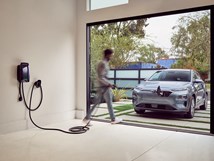Williams Engineering Touts Dual-Chemistry Battery
U.K.-based Williams Advanced Engineering Ltd. is developing a next-generation battery that uses two types of lithium-ion cells to improve performance.
#hybrid
U.K.-based Williams Advanced Engineering Ltd. is developing a next-generation battery that uses two types of lithium-ion cells, which the supplier claims will eliminate tradeoffs between energy and power density.

A proof-of-concept model of the so-called Adaptive Multi-Chem system teams Samsung cylindrical cells that provide good energy density with higher-power A123 pouch cells. Initial testing indicates the design can increase energy density by as much as 37% and cut weight by 30%.
The company presented the technology at this week’s Cenex LCV show in the U.K. The 60-kWh display unit weighs just 345 kg (760 lbs).
The architecture packages the two types of cells in separate modules within the battery. Each pack has its own bi-directional DC/DC converter to control energy transfer between the two cell types.
Pouch cells typically release energy faster, which enhances acceleration but depletes range. In the dual-chem design, high-density cylindrical cells can top off the pouch units as needed.
Williams aims to begin small batch prototype manufacturing of the new battery within the next year. Initial applications are expected to focus on electric hypercars, race cars and aerospace applications.
The battery module also features an exoskeleton manufactured using Williams’ “223” lightweighting technology. The design enables rapid, low-cost composite production and the use of recycled materials that yields an exceptionally high strength-to-weight ratio, according to the supplier.
RELATED CONTENT
-
Choosing the Right Fasteners for Automotive
PennEngineering makes hundreds of different fasteners for the automotive industry with standard and custom products as well as automated assembly solutions. Discover how they’re used and how to select the right one. (Sponsored Content)
-
on lots of electric trucks. . .Grand Highlander. . .atomically analyzing additive. . .geometric designs. . .Dodge Hornet. . .
EVs slowdown. . .Ram’s latest in electricity. . .the Grand Highlander is. . .additive at the atomic level. . .advanced—and retro—designs. . .the Dodge Hornet. . .Rimac in reverse. . .
-
Mustang Changes for 2018
On Tuesday Ford unveiled—using the social media channels of actor Dwayne Johnson (this has got to unnerve some of the auto buff book editors)—the 2018 Mustang, which has undergone some modifications: under the hood (the 3.7-liter V6 is giving way to a 2.3-liter EcoBoost four, and a 10-speed automatic is available), on the dash (a 12-inch, all-digital LCD screen is available for the dashboard), at the tires (12 wheel choices), on the chassis (MagneRide damper technology is being offered with the Mustang Performance Package), and on the exterior (three new paint colors). And while on the subject of the exterior, there are some notable changes—a lower, remodeled hood, repositioned hood vents, new upper and lower front grilles, LED front lights, revised LED taillamps, new rear bumper and fascia.










